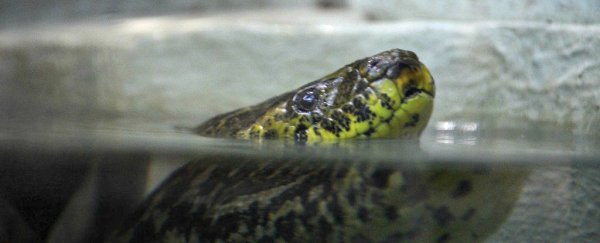Animal control officers in the US got a shock on a recent callout, when they discovered a young yellow anaconda (Eunectes notaeus) in a toilet bowl in an apartment building in Arlington, Virginia – which is a very long way from its natural habitat in the watery rainforests of South America.
The snake has a reputation as one of the largest snake species in the world, but this little guy measured roughly 1.5 metres (5 feet) long, making it quite small for a species that can grow up to 4.4 metres (14.4 feet) and weigh up to 35 kilograms (77 pounds).
"Last week, our Animal Control team received a call about a snake in the toilet of a local apartment. Officer Brenys White was able to safely remove the snake from the toilet and brought him back to the shelter," officials with the Animal Welfare League of Arlington wrote on their Facebook page.
"We were all in for a bit of a surprise - we were expecting him to be a wild snake or a ball python, but the snake is, in fact, a juvenile yellow anaconda!"
Here's the snake, happy and healthy, in its new enclosure at the animal control facility:
 Animal Welfare League of Arlington/Facebook
Animal Welfare League of Arlington/Facebook
You've most likely heard stories like this before: an animal – likely a snake or a rat – makes its way up sewer pipes and into some unsuspecting person's toilet.
One man, back in 2013, even had his penis bitten by a non-venomous snake while he was using the toilet. He recovered, but still, what a horrible way to spend an afternoon.
Despite the stories being widely reported, it's actually an incredibly rare event. So what's happening here?
Well, officials in Arlington haven't come forward with their own hypothesis about how the snake got there as yet, but, in general, there are quite a few ways a snake can end up inside a toilet bowl.
In this case, the anaconda, must have been someone's pet because its natural habitat – the watery areas of South America – is very different to the plumbing systems of urbanised Virginia. So, it only leaves really two options for how it got into the apartment and then into the toilet.
The first option is that it was someone's pet inside the building. It broke free from its enclosure, climbed through a vent or under a door, ended up in the bathroom, and curled up inside the tight porcelain toilet bowl to hide, an area that seems gross to us, but is a pretty sweet chill spot for a water-loving snake.
The second option is that the snake somehow got into the sewer pipe connected to the apartment – either by escaping its enclosure inside the building or coming up from a pipe connected to the outside – climbed all the way through the pipes, and came out of the toilet.
While this second scenario is possible, especially for an anaconda, it's less likely than option number one, because snakes are cold blooded and would not cope well in the chilly sewers beneath the street.
The main issue here is people getting pets that they don't properly know how to care for or keep safe. This is especially true for anacondas, which, unlike other popular pet species like ball pythons, are more hostile and grow to incredibly large sizes, two factors that people often overlook when buying them.
"Captive-bred anacondas can make calm, tractable pets when raised properly, but they do get large, and their strength should be respected," Jordan Russell, at Reptile Magazine, explains in a guide about owning green anacondas.
"This is not a species for anyone under the age of 18 or for anyone who does not have a reasonable amount of experience working with large constrictors."
In fact, owning an anaconda in the US comes with a whole slew of rules. The largest, called the Lacey Act, prohibits transport of anacondas across state lines, a law designed to keep them from escaping and ruining local ecosystems.
While there are many reptile enthusiasts who keep perfect care of their pets, if snakes do get out of their enclosures, it can be bad news for a habitat. One look at how Burmese pythons have taken over the Florida Everglades perfectly illustrates what can happen if people lose or abandon their pets into the wild.
According to the National Parks Service (NPS), more than 2,000 Burmese pythons have been taken out of the Everglades between 2000 and 2012, but there are still way too many for the ecosystem to handle.
"The population of Burmese pythons presently established in the park is the result of accidental and/or intentional releases by pet owners. These introductions can have devastating consequences to our ecosystem," NPS officials say.
"By preying on native wildlife and competing with other native predators, pythons are seriously impacting the natural order of south Florida's ecological communities."
To solve this, the Florida Fish and Wildlife Conservation Commission has even organised events to hunt down some of the snakes.
As for the yellow anaconda that was recently removed from the apartment, animal control agents say that it is healthy and is being taken care of by a specialist.
"Luckily, we were able to find a specialist who is familiar with his species and will be able to give him the care that he needs," they wrote in a Facebook post.
"They need specialised care and housing, and while they are non-venomous, can be dangerous when they reach full size and are not well-socialised. Plus, no-one likes being surprised by a lost and confused snake in their toilet!"
